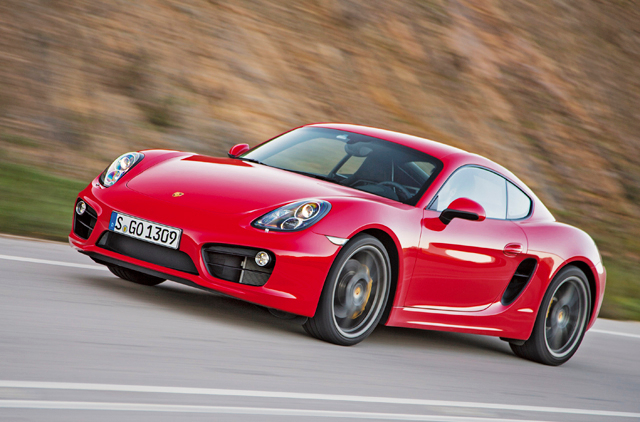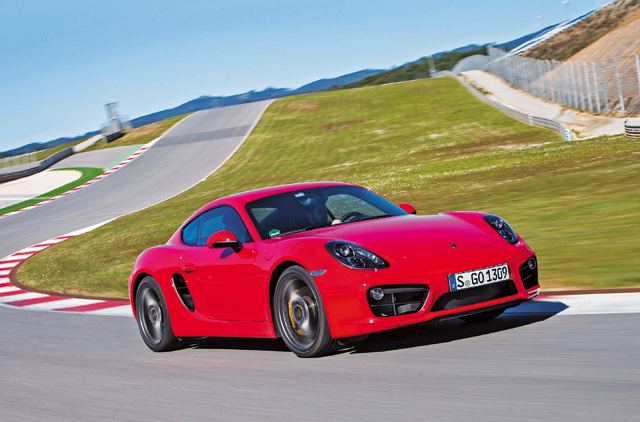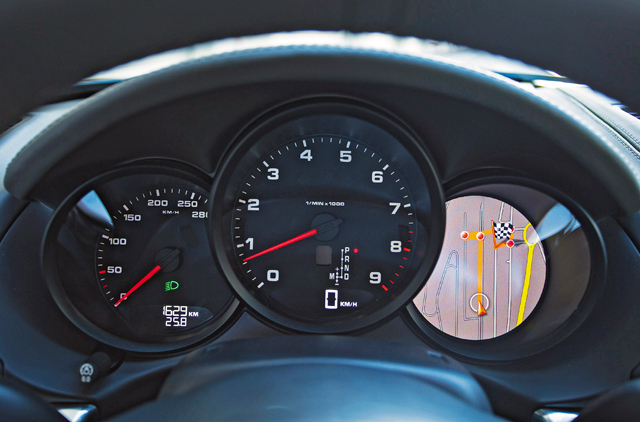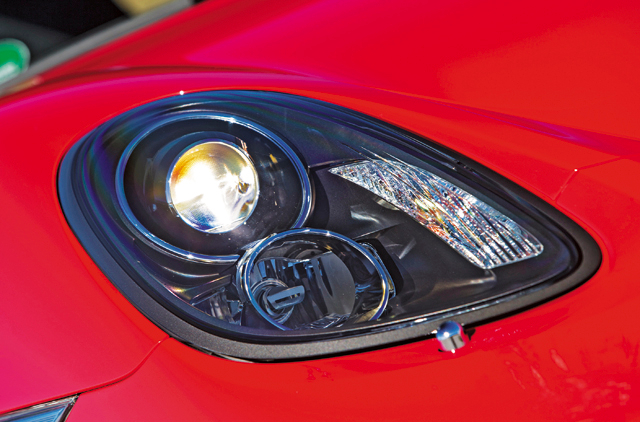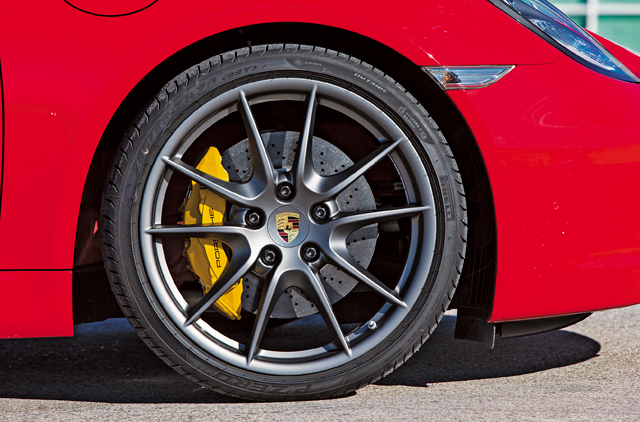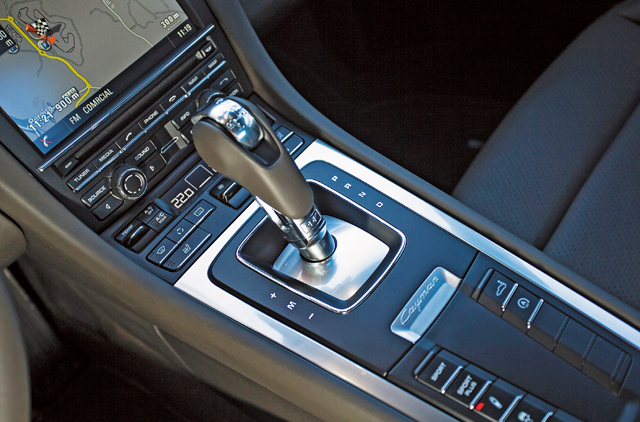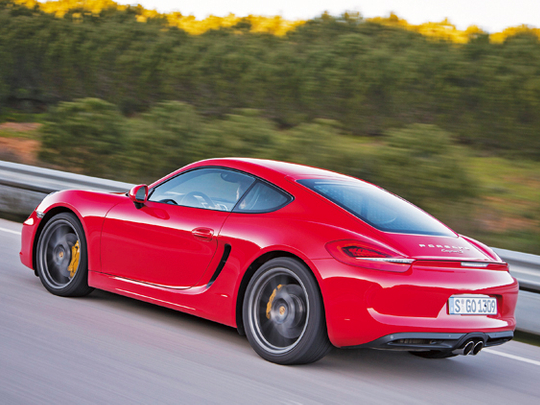
Long live the siesta, and soundly may they all sleep. Apart from handfuls of village teenagers who won’t conform to the mid-afternoon power nap and instead hang out at roadside cervejarias, and some 90-year olds in tattered Fiats/Renaults/Seats, there is no one on the roads. No one. There are a few police cars tucked away in turnings, but the cops are sleeping in them.
Then through one village a fat man peels away from the outdoor coffee bar and flaps his arms about waving an imaginary Le Mans starting flag. He’s not very concerned about his fellow townsfolk, but I oblige and step on it off the line, the resonance of a flat-six ringing towards 7,500rpm through a tunnel of oak trees, amplifying, heightening, sharpening, stabbing away at the ears, echoing. Wakey, wakey, Portugal... Uh-oh, and I’ve just put it in sports mode...
I know little about the Cayman at this point other than that things are starting to become very twisted in my mind’s established impression of sportscars. This is just unbelievably good. Porsche has flown us to Faro, southern Portugal, with great difficulty and a minor international crisis at the Munich airport, but after three flights we finally get there, and then stumble into a shuttle for a quick drive to a nearby Porsche dealership (with luxury tax, a well-specced Boxster S is half a million dirhams, or a good Dh200K more than back home).
There is no brief, no conference, just a dangling key and a flurried scurry around the parking lot identifying the allotted cars. I spot my ‘S GO 1309’ sitting there in uninspiring Guards Red. Some clues around the car proclaim all is good, though: a Cayman S, with a PDK ’box and proper up/down shift paddles behind the steering wheel plus optioned-up 20in wheels with the stickiest of the three available tyre choices, the P Zero Pirellis.
Orientation takes all of two seconds; the driving position is perfect, the telescopic steering wheel all the way out and just hiding the top edges of the centrally-mounted tachometer, all buttons left alone and the car is in normal, automatic mode. I’ve done this all many times before in the new Boxster S — the cabins are identical.
The throttle pedal, like in all proper Porsches, is heavily sprung and even throughout. I skip the formalities and just bury it into the carpet. The sat-nav lady will do the rest guiding us to the beachside hotel 120km away. She is accommodating and takes us straight into the hills.
The Porsche Cayman S makes light work of pensioners in Fiestas, and maybe even short convoys of them being lost all together, but the corners come up fast and tight, and perhaps 325 naturally aspirated horsepower makes a few manoeuvres a bit risky with ever-disappearing road, and appearing trees. This is not a twin-turbocharged AMG locomotive. Noted.
The typical horizontally opposed engine torque curve dips into a flat spot between 2,500rpm and 4,000rpm — which is exactly where I’m keeping the brisk Cayman S most of the time, shifting at maybe 6,000rpm, still 1,400rpm off peak power — but I don’t even notice. There’s a maximum of 370Nm of torque, so if you’re stuck with only 330Nm you’re not at much of a loss.
Yet the sprints between switchbacks reveal that the Cayman S lacks only in straight-line dynamics, as the right gear is always necessary and double down-shifts ensure every corner is taken with power in surplus — it doesn’t matter how much is in surplus, the new Cayman can carry it all through the curve.
The handling is sublime. It is noticeably tighter and quicker to react than the open-top Boxster, even though I swore that there’s no way I’d be able to tell the difference after first sampling Porsche’s convertible two-seater. But this is just better. Be careful what you wish for because, personally, if I won the lottery I wouldn’t know how to spend the money. Wind in the hair with the Boxster, or the best-handling chassis in the real world with the Cayman.
Even Portugal’s ruts and intruding kerbs on the roads don’t unsettle the Cayman with its wider track and lower centre of gravity than before. In fact one of the characteristics that speak best about the new coupé is its immediate return to composure after a crest or a dip throws the car off line — it is instant to ease your mind and lower your pulse, once again allowing you to rush the next hairpin and attack it with barely crossed arms. The steering is so sharp.
All too soon these abandoned hilly roads and curves melt into a sweeping, brand-new highway that seemingly nobody else in Portugal has ever heard about. Either that or Porsche has some serious pull with the local authorities. It is dead quiet, completely deserted on a working day in the middle of the afternoon.
The hotel is 60km away and at, err, fairly brisk average speeds over bumps and dips (it’s a new highway, a toll road in fact, but it’s not perfect), the car whooshes through the air like a good coupé should, only occasionally translating the road’s unevenness with slight jerks in the steering wheel. This is enlightening enough. I guess I can test out the ride quality at the marble-smooth Algarve race track in the morning... I do 15 laps (five as a passenger, very useful, that; 10 with a six-speed manual equipped car) in a Cayman S sticking to the back (nearly) of the lead 911.
The dirty line of the track is established quickly — the Pirellis are chipping away at themselves everywhere and scattering rubber marbles, but they mostly last all day and stick fanatically. The power is up by 5bhp in the 3.4-litre Cayman S but the main difference is in engine breathing. Engineers also played with the car’s electronics and the Porsche Stability Management (PSM) can hold shifts depending on yaw angle and steering input.
Straight away on the solid brake pedal on the downhill towards the start of a lap, and the third-gear right with a dip in the middle teases the back end, the Cayman immediately dropping again on its suspension and tracking dead ahead... For another third-gear turn, that’s more of a curved braking zone for the first of many hairpins.
The Cayman now comes with electromechanical power steering that’s the best of its kind and it still connects you to the front wheels. Sharp pump on the brake and the car detects the camber of the track, dropping slowly into the entry for that first hairpin before I begin to turn. Through the corner you can get back on it very early and allow Porsche Torque Vectoring and braking interventions on the correct wheel together with the mechanical diff to keep things tidy.
PTV and PSM are very similar systems, but one is for safety and the other aids performance. Even in sport mode, PSM and its stability-oriented programming win. You need to switch off traction control to let PTV step in. On the uphill straight there’s nothing more a right foot can do. The Cayman S revs free but lacks shove, and the 911 disappears over the crest and drops into braking for the second hairpin.
I wait until I’m almost at the bottom of the steep hill to brake, and the Cayman S wiggles before turning in sharply still with the middle pedal trailing off. It’s got 911 brakes up front anchoring 30kg less than before (the Cayman S weighs 1,350kg with a PDK ’box). Cayman project manager Jan Roth says the car’s literally half 911 and half Boxster. The clutch in today’s six-speed manual Cayman S drops easily and the pedals are perfectly placed; the gears come slick and fast.
Algarve’s roller-coaster really gets going now. Porsche tried to save a little weight everywhere, and already the low kerb weight proves how controllable and responsive the Cayman is. You forget you’re missing the Boxster’s sky overhead because you’re making noticeably faster forward progress, too fast to relax. Almost 44 per cent of the car’s frame is aluminium, and there have been huge strides in the rigidity of the Cayman’s new chassis. Engineers also lowered aerodynamic lift by 25 per cent with that new lip spoiler (mounted higher than on the Boxster).
A blind left kink, a fast right sweep, and another curved braking zone for a wide hairpin plummeting down again, hooking up and left further on. Everyone here at the Cayman launch agrees this Portimão circuit is one of the most enjoyable places anyone could ever drive. The car lurches under the electronics’ eager attempts to cull corner-exiting power, but subsequent laps with free rein let the Cayman skimp under your fingers and feet, like a puppet, sometimes getting tangled and wild, but still, always on your strings. It’s so controllable, fast, rewarding and educational.
When too much power gets through, the mid-engined chassis pivots around its centre and quick reactions are needed, but letting the car settle nicely through the turn and noting how little steering lock you’ve got, and reading the surface and the grip over the kerbs is just as much fun. Once again we’re dropping down another hill and emerging at the bottom for the final turn.
This one is vicious, changing camber two or three times, blind on entry, takes forever even in a Porsche, two clipping points... The Cayman is on a different line every time (that would be me), but it pulls through the fast right curve grabbing the apex on call, tidying things up over bumps, just clawing out of there. It has immense grip, a huge breadth of abilities. And the 911 disappears again up the start/finish straight...
Porsche hates Cayman/911 comparisons. The company’s legendary rear-engined sportscar has significantly more power, rear seats for babies, and the prestige. The new mid-engined coupé is the greatest-handling sportscar. Two different buyers buy the two different cars, Porsche’s people repeat. A 911 is a 911, but the Cayman S is just better. Which different buyer do you want to be?


